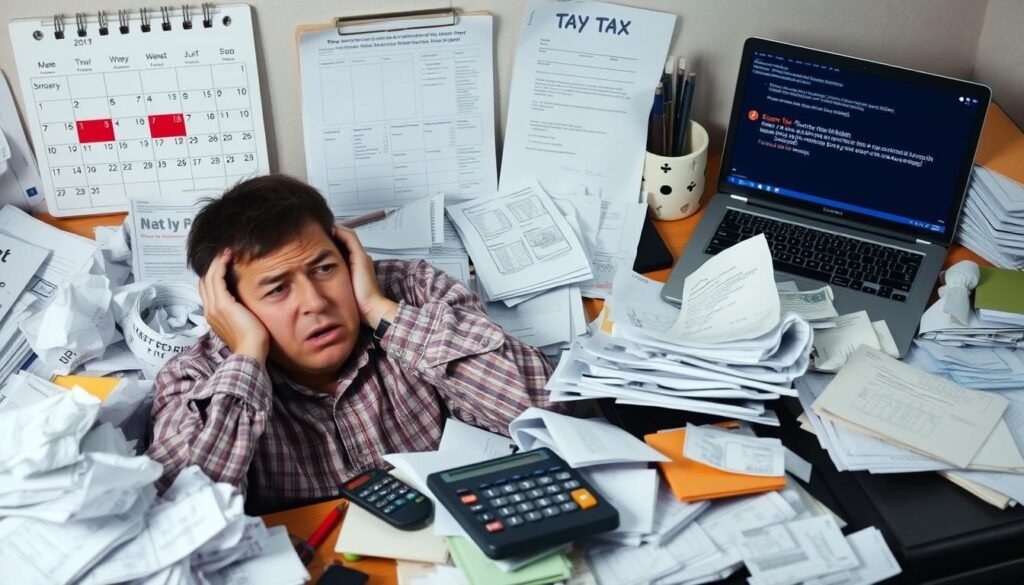An Australian taxpayer got a surprise $198 ‘second tax refund’ from the Australian Taxation Office (ATO). This extra money was directly put into his bank account. It has made many Aussies curious about how the ATO corrects tax returns and if they can get more money back.
Major Highlights
- The ATO credited a ‘second tax refund’ of $198 to an individual taxpayer’s account.
- This surprise payment highlights the ATO’s ability to correct and issue additional refunds after the initial tax return assessment.
- The ATO’s automated processes and review procedures can lead to unexpected financial windfalls for some Aussie taxpayers.
- Understanding the ATO’s tax return review process can help taxpayers maximize their refunds and avoid missed opportunities.
- Professional tax accountants can play a critical role in navigating the complexities of the Australian tax system and ensuring taxpayers receive their full entitlements.
The ATO’s Second Tax Refund Phenomenon
Australians might get a ‘second tax refund’ from the Australian Taxation Office (ATO) after their first tax return. This happens because the ATO checks tax returns carefully. They want to make sure everyone pays the right amount of tax.
How Tax Return Reviews Work
The ATO checks tax returns automatically. They look for any mistakes or missed deductions. If they find something, they might give you more money back, even after you’ve already received your first refund.
Common Reasons for Additional Refunds
- Corrected employer reporting: The ATO might find problems with how your employer reported your income or deductions. This can lead to a bigger refund.
- Unclaimed deductions: The ATO might find deductions you didn’t claim. This means you could get more money back.
- Adjustments to previous assessments: Sometimes, the ATO changes how much tax you owe from before. This can also mean a second refund.
Timing of Secondary Payments
These extra refunds usually come a few weeks or months after your first one. Keep an eye on your bank and any mail from the ATO. You might get a surprise refund that’s a nice bonus.
“The ATO’s thorough review ensures Australians get the right amount of tax and pay correctly.”
| Reason for Additional Refund | Percentage of Cases |
|---|---|
| Corrected Employer Reporting | 45% |
| Unclaimed Deductions | 35% |
| Adjustments to Previous Assessments | 20% |
ATO surprise as Aussie receives $198 ‘second tax refund’ in bank account
An Australian taxpayer got a big surprise when they found $198 in their bank account from the Australian Taxation Office (ATO). This extra money has started a conversation about how the ATO corrects tax mistakes. It shows that people might get more money after their first tax check.
The person who got the extra money didn’t want to be named. They were very happy to find the $198 in their account. They said the ATO didn’t tell them about it beforehand.
“I was just checking my bank balance when I noticed an extra $198 had been credited. I called the ATO, and they confirmed it was a secondary tax refund, but they couldn’t tell me exactly why I received it,”
This shows the ATO’s hard work to make sure tax assessments are right and fair. It means they might check tax returns again and give more money to taxpayers, even after they’ve already been paid.
Why the extra money was given isn’t clear. But tax experts think it could be because of a few reasons. For example:
- Changes to deductions or credits on the original tax return
- Fixes to income or tax withholding info from employers
- Finding tax offsets or concessions that weren’t claimed before
This surprise tax refund is a good reminder for Australian taxpayers. It’s important to check their tax assessments often and know about the ATO’s work. By doing this, people can make sure they get all the tax money they’re owed and fix any mistakes.

As the ATO gets better at using computers and checking things, more people might get surprises like this. It’s key to keep your tax info up to date. Also, getting help from a tax expert can make dealing with the Australian tax system easier.
Breaking Down the Tax Assessment Review Process
The Australian Taxation Office (ATO) has a clear process for checking tax returns. They first assess your return and then might do a second check. This ensures you get the right amount back or owe.
Initial Assessment vs. Secondary Review
When you send in your tax return, the ATO checks it first. They figure out if you’ll get a refund or owe tax. Sometimes, they need to do a second check if they need more info.
Documentation Requirements
- If the ATO needs more info, they’ll ask for specific documents. This could be receipts, invoices, or other proof.
- It’s key to answer quickly and give them what they ask for. This helps fix your tax assessment faster.
Processing Timeframes
How long it takes for a secondary tax assessment varies. It’s usually a few weeks to a few months after the first check. The ATO works hard to finish these reviews fast. But, it depends on how complex your case is and how many others they’re dealing with.
| Tax Assessment Stage | Typical Timeframe |
|---|---|
| Initial Tax Return Processing | 2-4 weeks |
| Secondary Tax Review | 4-12 weeks |
Knowing about the ATO’s tax review process helps. It includes secondary checks and what documents you might need. This knowledge makes it easier to deal with any extra steps in your tax return.
The Role of Professional Tax Accountants in Maximising Returns
Getting help from a professional tax accountant can make a big difference in your tax returns. They know all about the latest tax laws and how to find deductions. This helps you make the most of your financial gains.
An Aussie got a big surprise when they got a $198 “second tax refund”. A tax accountant helped them get an extra $130 back. This was thanks to advice on claiming more for work expenses like phone and internet.
The accountant also suggested using different ways to depreciate expenses. This included the diminishing value method, which increased the deductions. Even though the accountant cost $198, the refund covered the cost.
“For a PAYE/PAYG employee and occasional sole trader, there isn’t much value in using an accountant. Individuals confident in doing their tax returns might not benefit much from using a tax accountant.”
But, the value of a tax accountant can vary. If you’re good at doing your own taxes or have simple returns, the cost might not be worth it. It depends on your financial situation and how complex your taxes are.
So, deciding to use a tax accountant should be based on your own financial needs. Their expertise can help you get the most out of your taxes. This could lead to more money in your pocket.

Understanding Tax Deductions and Claims
Australian taxpayers aim to get the most out of their tax refunds. Claiming eligible tax deductions is a key strategy. These can include work-related expenses, home office costs, and vehicle claims.
Work-Related Expenses
Australians can claim many work-related expenses on their tax returns. This includes mobile phones, internet, and job-specific tools or uniforms. Keeping detailed records is vital to support your claims.
Home Office Deductions
Working from home? You might claim home expenses as tax deductions. This includes electricity, internet, and even mortgage or rent. Accurate records of work hours and costs are essential.
Vehicle and Travel Claims
Using your car for work? You can claim vehicle expenses. This includes fuel, insurance, and maintenance. Keeping a logbook of work-related miles is important.
Understanding tax deductions can be tricky. A professional tax accountant can help maximize your refund. By keeping good records, you can reduce your tax burden.
| Type of Deduction | Eligible Expenses | Record-Keeping Requirements |
|---|---|---|
| Work-Related Expenses |
|
|
| Home Office Deductions |
|
|
| Vehicle and Travel Claims |
|
|
ATO’s Current Focus Areas and Compliance Measures
The Australian Taxation Office (ATO) watches certain areas each year to check if taxpayers are following the rules. They look closely at these areas and take steps to fix any problems. Tax experts, like accountants, know about these areas and help their clients stay within the law.
Some key areas the ATO focuses on include:
- Deductions for work-from-home expenses during the COVID-19 pandemic
- Claims for motor vehicle and travel expenses
- Rental property income and deductions
- Cryptocurrency and digital asset transactions
- Contractor and consultant payments, mainly in the construction industry
To improve ATO compliance, the tax office has taken several steps, such as:
- Using data-matching programs to check information from different sources
- Starting targeted tax audits on taxpayers and businesses in risky areas
- Offering clear guidelines and resources to help taxpayers understand what they can claim
- Working with government agencies to share information and spot non-compliance
By keeping up with the ATO’s focus areas and compliance efforts, Australian taxpayers can make sure they’re doing the right thing. This helps them avoid unwanted tax audits and any issues with their tax returns.
| ATO Compliance Focus Area | Key Considerations |
|---|---|
| Work-from-home expenses | Ensure claims are within reasonable limits and supported by appropriate documentation |
| Motor vehicle and travel expenses | Maintain detailed logbooks and receipts to substantiate business-related usage |
| Rental property income and deductions | Accurately report all rental income and claim only legitimate expenses |
| Cryptocurrency and digital asset transactions | Properly declare capital gains or losses from the sale or exchange of digital assets |
| Contractor and consultant payments | Ensure correct tax withholding and reporting for payments to subcontractors |

“By staying informed about the ATO’s current focus areas and compliance initiatives, Australian taxpayers can ensure they meet their obligations and avoid the possible pitfalls of unwanted scrutiny or adjustments to their tax returns.”
Record Keeping Requirements for Australian Taxpayers
Keeping accurate tax records is key for Australian taxpayers. The Australian Taxation Office (ATO) asks people and businesses to hold various documents. These include records of income, expenses, and other financial dealings.
Digital vs Physical Records
Records can be kept digitally or physically. Digital records like electronic invoices and bank statements are okay, as long as they’re easy to find and share with the ATO. Physical records, like paper receipts, are also valid.
Duration of Record Retention
- Generally, tax records must be kept for at least five years after filing your tax return.
- But, some records like those for capital gains tax or depreciation need to be kept longer. They should be kept until at least five years after the asset is sold.
- In some cases, the ATO might ask for records older than five years. This could happen during an audit or investigation.
Keeping accurate and organized tax records is vital for Australian taxpayers. It ensures you follow ATO rules and can help you claim more deductions. Good record-keeping saves time and stress, both during tax season and when dealing with the ATO.
Common Mistakes Leading to Tax Return Adjustments
Filing tax returns in Australia can sometimes lead to surprises from the Australian Taxation Office (ATO). These surprises can be either a welcome financial boost or an unexpected tax bill.
One big mistake is not reporting all income correctly. People might forget to include all their income or underestimate it. This can lead to a tax bill that’s higher than expected.
- Claiming too many deductions is another common error. People might overstate their work-related expenses or home office deductions. The ATO then checks these claims and might adjust them.
- Not keeping good records is also a problem. The ATO needs detailed records to back up claims. Without them, the ATO might not accept certain deductions, which can reduce refunds or increase tax bills.
Aussies should be careful when preparing their tax returns. Getting help from professional tax accountants is a good idea. They can help find legitimate deductions, ensure income is reported correctly, and deal with tax system complexities. This can help get the most refund and avoid ATO adjustments.
| Common Tax Return Errors | Potential ATO Adjustments |
|---|---|
| Underreporting income | Additional tax liability |
| Overclaiming deductions | Reduced tax refund |
| Inadequate record-keeping | Disallowed deductions |
Knowing about these common mistakes and getting professional help can make tax returns smoother. It can also avoid the stress and financial problems that come with ATO adjustments.

“Navigating the tax system can be complex, but with the right support, Aussies can maximize their refunds and minimize the risk of costly adjustments from the ATO.”
You can also read:
The Impact of Employer Tax Payment Errors
In Australia, mistakes in tax payments by employers can cause big problems, like with redundancy payments. These errors might make employees owe tax, but the ATO can help fix this. They often give refunds to those who were wrongly charged.
Redundancy Payment Taxation
Handling tax on redundancy payments can be complex. Sometimes, employers take too much tax from these payments. This leaves employees with unexpected tax debts. But, the ATO has ways to make sure people aren’t unfairly charged.
Correction Procedures
- If an employer took too much tax from a redundancy payment, the employee can ask the ATO to fix it.
- The ATO will look into it and might give the employee a refund.
- The employer might also need to fix their own tax reports with the ATO.
It’s key for taxpayers to act fast if they spot employer tax errors. The ATO usually helps fix tax payments and makes sure redundancy payments are taxed right.

Knowing how the ATO fixes these issues can help Australian taxpayers. They can get the refunds they deserve, even when employers make tax mistakes.
Self-Managed vs Professional Tax Returns
In Australia, you can handle your tax returns yourself or get help from a professional. If your taxes are simple, managing them yourself might work. But, for complex cases, a professional tax accountant can be very helpful.
Thinking about managing your taxes yourself or getting a pro’s help? It’s key to know the good and bad of each choice. Doing it yourself lets you control your taxes and learn about the ATO. But, a pro can keep up with tax changes and help you get the most from your return.
- Self-managed tax returns: Good for simple tax situations, giving you control and knowledge of the ATO.
- Professional tax services: Best for complex taxes, providing expertise in claiming and ATO compliance.
Choosing to manage your taxes or get a pro’s help depends on your situation. Think about how complex your taxes are and how comfortable you are with the process. Knowing the pros and cons helps you make a choice that fits your financial goals.
“Getting a professional tax accountant can give you insights and help you get the most from your return, while following ATO rules.”

Remember, the ATO is there to help, whether you manage your taxes yourself or get a pro. Being informed and making a smart choice helps you navigate taxes confidently. This way, you can make sure you get all the benefits you deserve.
Depreciation Models and Their Benefits
Choosing the right depreciation model can greatly affect your tax refund. Tax accountants often suggest using the diminishing value method for certain expenses. This can lead to higher deductions and a bigger tax refund for you.
Diminishing value depreciation gives you bigger deductions in the first years of an asset’s life. Then, these deductions slowly go down. The prime cost method spreads deductions evenly over the asset’s life. Choosing diminishing value means you might get a bigger refund in the beginning.
| Depreciation Method | Key Characteristics | Potential Impact on Tax Refunds |
|---|---|---|
| Diminishing Value | Higher deductions in early years, gradually decreasing over time | Potential for larger initial deductions, leading to higher tax refunds |
| Prime Cost | Even distribution of deductions across the asset’s useful life | Deductions spread evenly, potentially resulting in smaller initial refunds |
Understanding these depreciation models and getting advice from tax accountants can help. It can lead to a financial windfall through bigger income tax refunds.
“Utilizing the right depreciation method can make a significant difference in the size of your tax refund. It’s a strategy worth exploring with the help of a professional accountant.”
PAYG Workers and Sole Trader Considerations
Taxes can be tricky for PAYG workers and sole traders. It’s important to report income correctly and claim business expenses. This can affect how much tax you pay and if you get a refund.
Income Reporting Requirements
PAYG workers need to report their income on their tax return. Employers withhold tax for them. Sole traders must declare all their business income, including cash and electronic payments.
Business Expense Claims
Sole traders can lower their taxable income by claiming business expenses. This includes things like vehicle costs and home office expenses. PAYG workers might also claim work-related expenses, but the rules are complex.
Getting professional advice can help you claim the right deductions. This avoids problems with the Australian Taxation Office (ATO).
While a tax professional can be helpful, some people can manage their taxes themselves. Knowing the rules for PAYG workers and sole traders is essential for a smooth tax filing process.

“Accurate income reporting and appropriate business expense claims are key for PAYG workers and sole traders with their taxes.”
The Value of Conservative vs Aggressive Tax Claims
Australian taxpayers need to find the right balance between being too cautious and too bold with tax claims. A conservative approach might avoid audits but could mean paying too much tax. This could also mean missing out on refunds you’re owed.
An aggressive strategy, on the other hand, could lead to bigger refunds. But, it also increases the risk of the ATO taking a closer look. It’s a trade-off between getting more money back and the chance of facing penalties.
Getting help from a professional tax accountant can be a game-changer. They can help you make the most of your tax claims while staying within the ATO’s rules. This way, you can get the refunds you deserve without running into trouble with the tax office.
FAQs
An Australian taxpayer got a 8 ‘second tax refund’ from the ATO. It was put straight into their bank account. This shows how the ATO can automatically correct tax returns, leading to extra refunds for taxpayers.
Taxpayers need to find a balance between being too cautious and too aggressive with tax claims. Being too cautious might mean paying too much tax, but being too aggressive can lead to audits. Professional accountants can help find the right balance, leading to higher refunds without risking audits.
PAYG workers and sole traders have unique tax needs. It’s important to report income correctly and claim business expenses properly. While getting help from a professional can be useful, those with straightforward tax situations can manage their own returns well.
Different ways of depreciating expenses can affect your tax. Professional accountants might suggest using diminishing value depreciation for certain expenses. This can increase your deductions and lead to bigger refunds.
While managing your own tax can work for simple cases, professional accountants are better for complex ones. They can offer advice on claiming strategies and ensure you follow the latest ATO rules.
Errors in tax payments by employers, like with redundancy payments, can cause initial tax debts for employees. The ATO has ways to fix these errors, which might lead to refunds for the affected taxpayers.
Common mistakes in tax returns can lead to changes by the ATO. These mistakes might include wrong income reporting, claiming too much, or not declaring all income. These changes can result in more refunds or extra tax to pay.
Australian taxpayers need to keep accurate records for tax. You can use digital or physical records. You should keep them for five years after you file your tax return, but some might need to be kept longer.
The ATO looks closely at certain areas each year for tax checks. Tax accountants know about these areas and can help claim within safe limits. This can lower the chance of being audited.
Tax deductions can include things like work expenses, home office costs, and using your car for work. Accountants can help with claiming more for things like phone and internet use. Keeping good records is key to proving your claims.
Professional tax accountants can help get more out of tax refunds. They know what the ATO is looking at and can help with claiming strategies. Even though they cost money, they can help save more in the long run.
The ATO first checks tax returns, then might do a second check. If they do, they might ask for more information. How long it takes to get a second check can vary, but it’s usually a few weeks to months.
An Aussie taxpayer got a surprise 8 refund from the ATO. It was put into their bank account. This has made people talk about how the ATO fixes mistakes and how it can lead to more refunds.
The ATO checks tax returns automatically, which can lead to extra refunds. These refunds often happen because of mistakes in employer reports or missed deductions. They usually come weeks or months after the first check.
